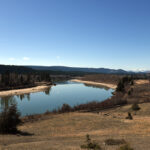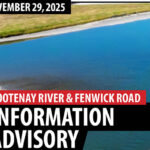Home »

A path forward on Marysville Benchland concerns
Letter to the Editor
In regard to the February 19 City of Kimberley public hearing, without interviewing every attendee individually on their motivation for occupying a seat in the gallery, it would be challenging to capture exactly the breakdown of the number of attendees supporting versus opposing the sale of the Marysville Benchland for industrial development.
But I would like to remind everyone that the public hearing was intended to discuss the OCP, as a whole. Reading between the lines, Kimberley residents by and large agree that the policy intended to guide decision-making on city land use planning is appropriate direction for the community. With one major exception; the proposed development of the Marysville Benchland.
Attendees who were for developing the benchland either expressed a personal business interest or they believed that this proposal would result in a decrease in their taxes. Others believed that buildings and pavement are beautiful, or implied that the land is contaminated and not of value for other uses.
Attendees against developing the benchland felt that the proposal will affect them and other community members detrimentally. From the concern that the inherent values of the land would be forever lost, such as the formative viewpoint, ecosystem services, accessible recreation for all, and cultural connection to the special spot, to the concern that they will be directly impacted, as adjacent residents, by whatever development is constructed (increased noise, increased traffic through residential areas, degradation of aesthetic, and the depreciation of property value.)
They also pointed out that there are options available for alternate locations for industrial development, there is no need to develop the benchland when better-suited lands exist (i.e., lands that are not characterized by the suite of unique values exhibited by the Benchland and are already associated with other, already developed industrial lands).
All attendees agree that avenues need to be sought to diversify the tax base that is used to provide necessary, as well as desired, community services. It is understood that in order to do this, the city needs to promote business development in the community. However, it is not clear exactly how much business development must occur to meaningfully offset the residential tax base (i.e., to reduce taxes), nor is it clear if that objective is achievable (realistically, there is a carrying capacity of the lands on the city boundary to support Kimberley residents, without altering existing developments, such as golf courses).
The city has publicly drawn comparisons to the revenue sources that existed when the Sullivan Mine was running, which may have given folks the impression that the development targets sought will top up the coffers to pre-mine closure conditions.
In looking at the OCP maps, it is difficult to image that sufficient lands exist in city limits that are not already locked up in golf courses, etc., to develop the number and type of businesses needed to generate as much revenue as a major mining project. It would be prudent to manage expectations of residents by better contextualizing what the business development targets need to be to warrant a tax reduction. It is natural for folks to choose the option that promises reduced taxes, however, in this case, there is a lot more required to fulfill that promise than a small development that will ruin a gem of a piece of city owned land.
In reality, meeting the objective of reducing taxes will be very challenging without doing all of the following: increasing the amount of industrial use land available, diversifying lands that are not meeting their potential for generating revenue, aggressively revitalizing the core business hubs, and implementing incentives for development of other undervalued properties strewn throughout the community.
The Marysville Benchland is small (tax revenue potential is relatively minor), it is unserviced, and access would need upgrading and improved maintenance. Focusing on developing this small piece of land that is precious to many residents is misleading because developing the benchland will tradeoff the ability to meet the other objectives by decentralizing business more than it already is.
Further, the idea that the land is only valuable for industrial use due to contamination is misinformed. The land is likely no more contaminated than many other properties in the city, properties that are now golf courses, soccer fields, ball parks, and residences. Zoning the benchland for industrial use does allow samples collected to be compared to lower numerical standards than if it were zoned recreational use, but this is inconsequential if the land is not sold or developed.
With all of this considered, my perspective is that to truly provide the best value of the Marysville Benchland for current and future generations, it should be maintained in its current state, owned by the bity, for use by all, rather than sold to individuals for use by a small number of people. I believe all the objectives can be met, while preserving the benchland, through innovative planning, community collaboration, and improved management of expectations.
Whether people personally think the concerns of Marysville Benchland supporters are valid or not, it is clear that they are very concerned. This unique and beloved piece of land occupies a very small amount of paper in the now 60 page OCP and the amount of attention it has received over the past few months is indicative of its importance to residents.
There are land options other than the Marysville Benchland that are better suited to the goals of the community and they should be optimized. The best decision the city could make is to modify the OCP to allow the Marysville Benchland to be preserved and focus on fulfilling the more impactful (with respect to revenue generation) objectives outlined.
If the city chooses instead to base the decision on a show of hands, then the count should stem from a vote, where residents have the ability to provide input without fear of retribution.
Jennifer McConnachie,
Kimberley
Editors note: City of Kimberley council is deliberating on the OCP at this evening’s (Feb. 26) meeting.







